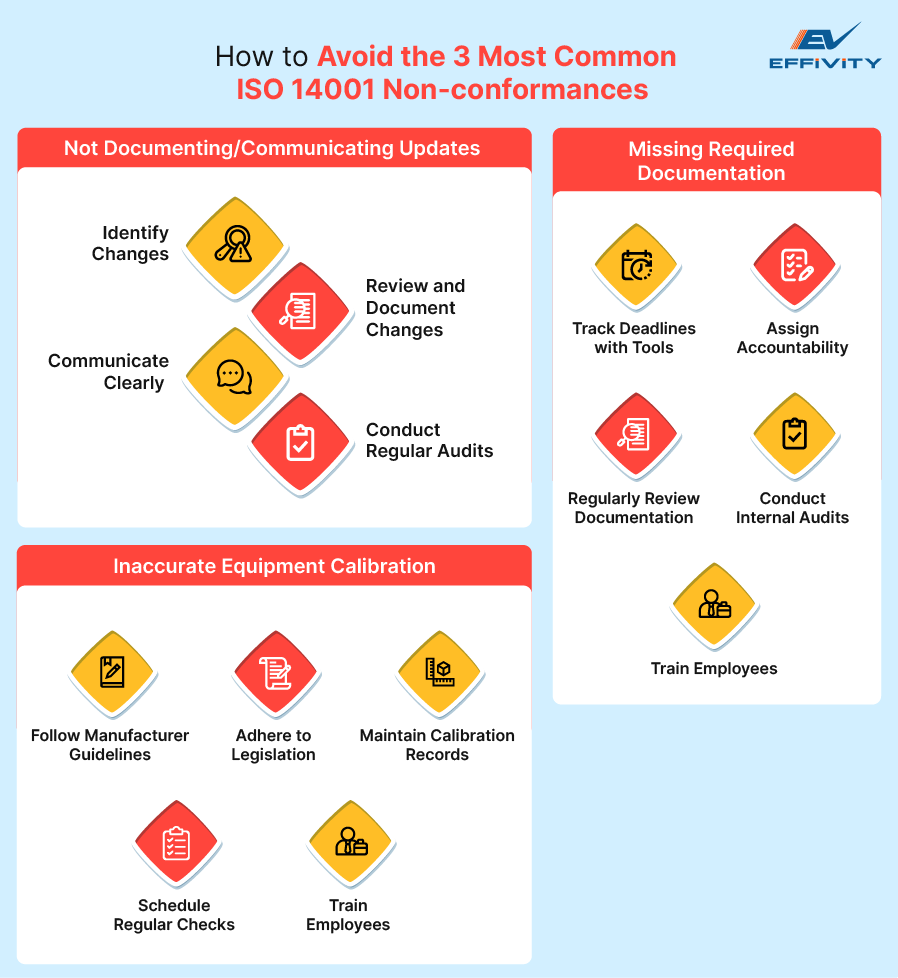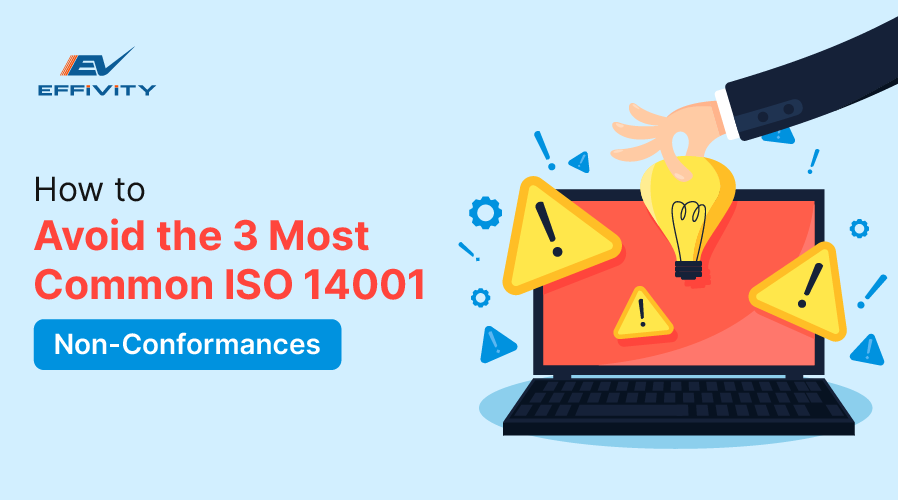Environmental implications are central to almost every discussion today. With growing concerns about the environment, organizations are expected to take more responsibility for ensuring sustainability. Customers and stakeholders are increasingly shifting their support to organizations that take their environmental duties seriously.
ISO 14001 is a standard that provides organizations with guidelines for achieving environmental sustainability. Compliance with this standard is a mark of continuous environmental commitment. However, achieving this standard is a multi-step process, and without the suitable systems in place, your organization can easily slip into non-conformance.
In this article, we shall examine the most common ISO 14001 Non-conformances and how, with careful planning and implementation of environmental management system software, they can be avoided.

1. Not Documenting or Communicating Process Improvements or Updates
One common non-conformance in ISO 14001 Environmental Management Systems is the failure to document or communicate process improvements or updates. Organizations often change their operations by introducing new equipment, updating procedures, or hiring new personnel. These changes are crucial for maintaining and improving the EMS. However, if these changes are not adequately documented, tracking improvements and ensuring compliance with ISO 14001 requirements becomes challenging. Failure to communicate these changes to all affected employees can lead to misunderstandings, errors, and inefficiencies.
Tips to Avoid
Identify Operational Changes:
Whenever operations change, such as new equipment or personnel, identify these changes and assess their impact on the EMS.
Review Process:
Ensure that every change undergoes a formal review process. This helps assess the potential impact on the EMS and ensures that all changes are necessary and beneficial.
Document Changes:
After the review, document every change thoroughly. Keep detailed records of what was changed, why, and how it impacts the EMS.
Communicate Clearly:
Once changes are documented, communicate them to all affected employees. Use various internal channels, such as emails, meetings, and training sessions, to inform all team members.
Timely Audits:
Schedule regular internal audits to verify that all process improvements and updates have been properly documented and communicated.
2. Missing Required Documentation
Another common non-conformance is missing required documentation. ISO 14001 EMS planning involves various compliance requirements, including environmental monitoring, regulatory reporting, and maintaining records. Missing documentation can occur when due dates are not tracked, responsible personnel are not clearly identified, or the documentation process is not well managed. Not only does missing required documentation result in non-conformance, but it can also lead to legal issues and penalties.
Tips to Avoid
Track Deadlines:
Use system tools to track all compliance deadlines. Automated reminders and alerts can help ensure that important dates are not missed.
Assign Accountability:
Clearly assign responsibility for submitting required documentation. Ensure that responsible persons understand their roles and the importance of timely submissions.
Regular Reviews:
Conduct regular reviews of the documentation process to ensure all records are complete and up-to-date. This includes checking for missing documents and ensuring that all required information is included.
Internal Audits:
Schedule internal audits to review documentation practices. This aids with identifying gaps and areas for improvement before external audits occur.
Training and Awareness:
Educate employees on the significance of maintaining precise and up-to-date documentation through training sessions. Ensure they understand the consequences of missing documentation and how to avoid it.
3. Inaccurate Equipment Calibration
Inaccurate equipment calibration is a frequent non-conformance issue in ISO 14001 EMS. Equipment used for monitoring environmental aspects must be calibrated and maintained according to manufacturer recommendations and any applicable legislation. If calibration is not performed accurately, the data collected may be unreliable, leading to incorrect assessments and decisions. This non-conformance can result in costly corrective actions, such as retesting, additional assessments, and more documentation.
Tips to Avoid
Follow Manufacturer Recommendations:
Ensure all equipment is calibrated and maintained according to the manufacturer's specifications. This includes following the specified frequency and procedures for calibration.
Adhere to Legislation:
Stay updated on any applicable legislation governing equipment calibration. Ensure adherence to all legal requirements to prevent non-compliance.
Maintain Calibration Records:
Keep detailed records of all calibration activities. These records should include information on when the calibration was performed, who performed it, and the results.
Schedule Regular Checks:
Set up a schedule for regular calibration checks and audits. This helps maintain ongoing accuracy and identify any issues early.
Training for Team Members:
Train employees on the importance of accurately calibrating and correctly performing it.
Environmental Management System Software for Consistent Compliance
Using Environmental Management System (EMS) software can enhance your organization's ability to maintain consistent compliance with ISO 14001 standards. The key benefits of using EMS software are:
1. Automated Documentation and Record-Keeping:
EMS software automatically generates and maintains essential documentation. This minimizes the chances of missing or incomplete records and ensures that all necessary information is always up-to-date and readily accessible. It also saves you time and resources.
2. Compliance Tracking and Alerts:
The software tracks compliance deadlines and regulatory requirements, sending automated alerts and reminders. This helps ensure that you never miss a crucial deadline or overlook an important regulatory update.
3. Centralized Data Management:
EMS software centralizes all environmental data in one place, making it easier to access, analyze, and report. This centralization facilitates better data management and allows for more informed decision-making.
4. Enhanced Reporting Capabilities:
The software provides advanced reporting tools that can automatically generate detailed reports on various environmental metrics. These template-based reports can be customized to meet specific organizational requirements, making it easier to demonstrate compliance and identify areas for improvement.
5. Improved Accuracy and Reduced Errors:
EMS software mitigates the chances of human error by automating data input and calculations. This leads to more accurate records and reliable data, which are essential for maintaining compliance.
6. Streamlined Audits and Inspections:
EMS software simplifies the audit process by facilitating access to all necessary documentation and records. This makes it easier to prepare for both internal and external audits, ensuring that you can demonstrate compliance with ISO 14001 standards.
Using EMS software ensures that your organization consistently meets ISO 14001 standards. The software's automation, accuracy, and efficiency help you maintain an effective environmental management system, ultimately contributing to better environmental performance and sustainability.






























